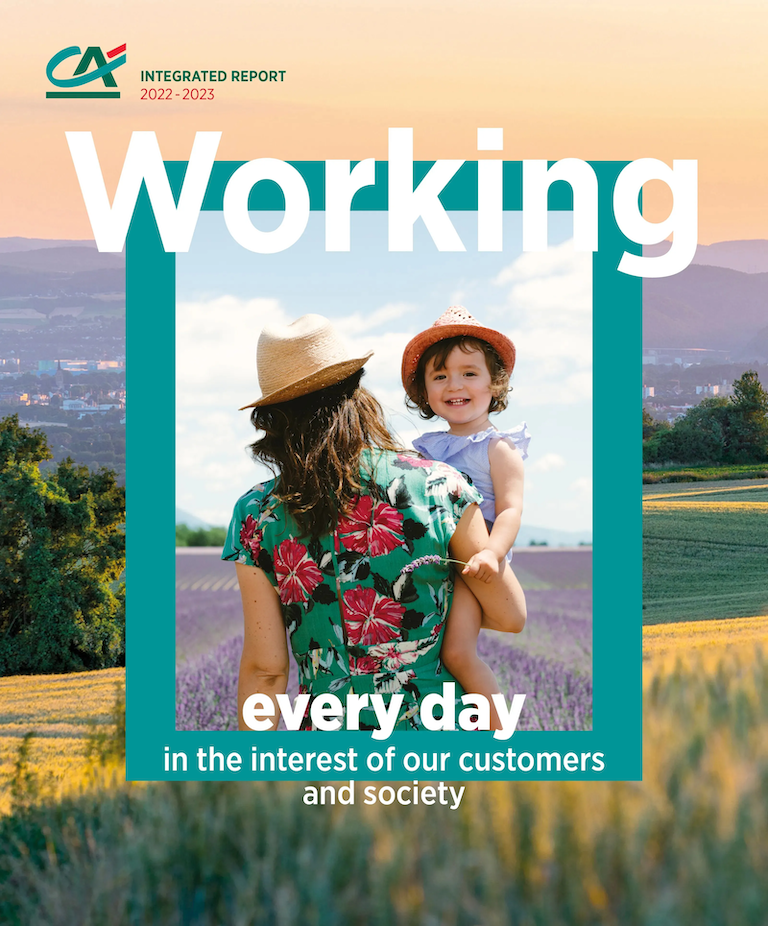Crédit Agricole S.A. results at an all-time high
Crédit Agricole S.A.’s 2022 results are historically high due to the dynamic trend in activity in all business lines. Thanks to its operational agility, Crédit Agricole S.A. met the targets of its 2022 Medium-Term Plan a year ahead of schedule and is on track to meet the targets set for 2025.
Crédit Agricole S.A. net income
Underlying net income Group share(1) was €5.5 billion, an increase of 1.3% over 2021 and above the target of €5 billion set in the 2022 Medium-Term Plan. This increase in income was driven by revenue growth in all business lines and control of expenses and the cost of risk.
(1) Excluding specific items
Crédit Agricole S.A. revenues
Crédit Agricole S.A. underlying revenues(1) amounted to €23.7 billion, an increase of +4.8% over 2021. This growth was driven by all the business lines, which recorded brisk business throughout the year, despite adverse market effects impacting asset activities in particular.
(1) Net banking income (NBI)
Underlying revenues were up +4.4% in fourth quarter 2022 compared to fourth quarter 2021. Crédit Agricole S.A.’s diversified business mix has led to an increase in revenues every quarter year-on-year since 2017.
Crédit Agricole S.A. cost/income ratio
The underlying cost/income ratio excluding SRF was 58.2% in 2022, below the target set in the Medium-Term Plan, and remains more than six percentage points below that of a sample of ten European banks.
Crédit Agricole S.A. cost of risk on outstandings
The underlying cost of risk stood at -€1,551 million and was up for the period (+25.9%/€320 million versus 2021). The increase in 2022 was due to the €113 million increase in provisioning for performing loans (€155 million in 2021 vs €268 million in 2022), largely related to provisioning following the outbreak of the Russia/Ukraine war in first quarter 2022. It also includes the €374 million increase in provisioning for proven risk, which returned to normal after a year of very low proven risk costs. That provisioning rose from €993 million in 2021 to €1,367 million in 2022 (quarterly average for 2022 comparable to that of 2019).
(1) The cost of risk on outstandings is calculated by dividing the cost of risk recorded over the full year by the average outstandings at the beginning of the four quarters of the year.
12.6% return on equity*
Payment of the 2022 dividend of €1.05 per share
Finalisation of the 2019 exceptional catch-up
The Crédit Agricole S.A. Board of Directors will propose a dividend of €1.05 per share in respect of 2022 net income at its General Meeting of Shareholders on 17 May 2023.
The dividend of €1.05 represents €0.85 per share under the policy to distribute 50% of net income and €0.20 per share for the balance of the catch-up on the 2019 dividend.
Exceptional financial strength
The Group’s financial strength stems from a high level of equity, which is a safety cushion in case of difficulties. The Group also has a significant level of liquidity reserves that it can draw on at any time, especially from the ECB.
At 31 December 2022, the Group’s solvency level remained very high, with a phased Common Equity Tier 1 (CET1) ratio of 17.6%, up +0.1 percentage point from end-December 2021. The Group benefits from a comfortable 8.7 percentage point margin between the level of its CET1 ratio at 31 December 2022 and the Supervisory Review and Evaluation Process (SREP) requirement set at 8.9% by the regulator. Likewise for Crédit Agricole S.A., the phased CET1 ratio stood at 11.2% at 31 December 2022, greater than the SREP regulatory requirement of 3.3 percentage points. The ratio integrates the impact of the dividend payment of €1.05 per share for the financial year 2022.
Group liquidity reserves
Liquidity is measured at Crédit Agricole Group level. The Group’s liquidity reserves, at market value and after haircuts, totalled €467 billion at 31 December 2022, an increase of €2 billion over 31 December 2021. They cover its short-term debt 4x over (excluding the replacements with Central Banks).
Crédit Agricole Group’s short-term LCR* at end-2022: 167.3%
Phased-in solvency ratios
At 31 December 2022, the fully loaded CET1 ratio of Crédit Agricole Group was 17.6% and that of Crédit Agricole S.A. was 11.2%.
The internal solidarity mechanism
In terms of solvency, Crédit Agricole Group is best-in-class among comparable European banks, with a phased-in CET1 ratio of 17.6% at 31 December 2022. This greatly exceeds the minimum regulatory requirements (8.9% at 31 December 2022). In accordance with the French Monetary and Financial Code, Crédit Agricole S.A., as the corporate centre of the Crédit Agricole network, is responsible for taking all necessary measures to ensure the solvency and liquidity of each member of the Crédit Agricole network, chief among them the Regional Banks and Crédit Agricole CIB. Crédit Agricole S.A. also acts as the central bank for the Regional Banks and in this capacity can intervene when refinancing is necessary.
A responsible compensation policy
Crédit Agricole S.A.’s compensation policy is consistent with the Group’s Raison d’Être and supports its long-term project and Medium-Term Plan. It is anchored by the implementation of principles shared by all employees and its components are determined objectively and transparently.
Compensation policy applicable to all employees
The compensation policy is one of the three founding principles of the Human Project: empowering employees, strengthening customer relations and fostering an atmosphere of trust.
The components of compensation for employees and executive managers are determined on the basis of precise, clear criteria that reflect competencies required, seniority and individual and group performance attained in terms of the organisation’s responsibility for sustainability. All or part of these elements may be offered to each employee, according to their level of responsibility, skills and performance.
-
Offering competitive and attractive compensation.
System: salary
People eligible: all employees
Base salary is commensurate with expertise and level of responsibility and is competitive with local market conditions for each business line.
-
Linking the interests of employees with those of the Group and shareholders, as part of the deployment of the Medium-Term Plan.
System: variable compensation
People eligible: all employees
Variable compensation is awarded on the basis of the achievement of individual targets and the results of each entity, in compliance with regulatory principles. Variable compensation is directly related to the annual performance and implementation of the three pillars of the Medium-Term Plan: the Customer, People and Societal Projects. Unsatisfactory performance, failure to comply with rules and procedures or at-risk behaviour have a direct impact on variable compensation.
-
Linking all employees to the Group’s results to enable the collective sharing of the value created.
System: profit sharing and incentive plans
People eligible: all employees in France
System: Profit sharing
People eligible: all employees of certain international entities
System: employee shareholding
People eligible: all employee shareholding except for in a few countries
-
Rewarding the long-term, collective performance of the Group and its entities.
System: long-term incentive plan
People eligible: “Talents” employees, senior managers, key executives of the Group
This component of variable compensation, which is unifying, motivating and encourages loyalty, completes the annual variable compensation mechanism. It consists of compensation in shares and/or cash indexed to the share price, based on performance.
-
Covering/supplementing healthcare reimbursements in the event of employee illness.
System: life and health insurance plans
People eligible: all employees in France
Protecting employees against life’s uncertainties
System: supplementary pension scheme
People eligible: executive managers
In addition to direct compensation, benefits in the form of pension plans, health and life insurance have been set up within the framework of group plans specific to each entity.
-
The positive ratings given in the publication of the gender equality index established by the French government highlights the effectiveness of the actions taken in the Group with regard to equal pay for men and women. This year, all entities achieved a score of at least 83/100.* The Crédit Agricole S.A. economic and social entity achieved a score of 91/100, up from 2021.
*With the exception of two entities representing fewer than 2% of employees.
-
83/100*
this is at least the score obtained for all entities this year
Compensation awarded to executive corporate officers in respect of 2022
The Chairman of the Board of Directors receives only fixed compensation.
Executive corporate officers’ annual compensation includes an immediate portion and a deferred portion awarded in the form of instruments that vest subject to the fulfilment of performance and employment conditions. It is composed as follows.
In 2022, the equity ratio between the level of compensation of each Executive Corporate Officer and the average compensation of the employees of Crédit Agricole S.A. in France was :
- 9 for the Chairman of the Board of Directors
- 34 for the Chief Executive Officer
- 19 for the Deputy Chief Executive Officers







